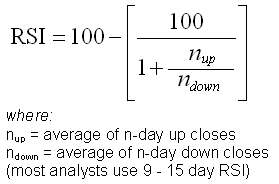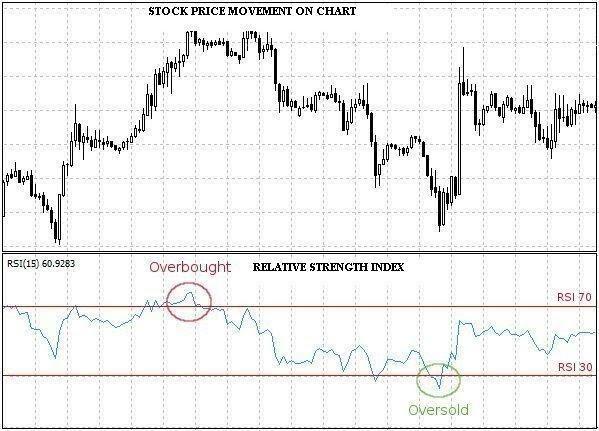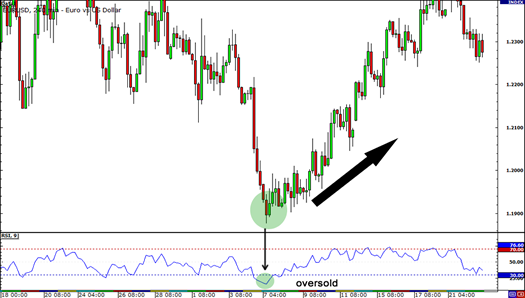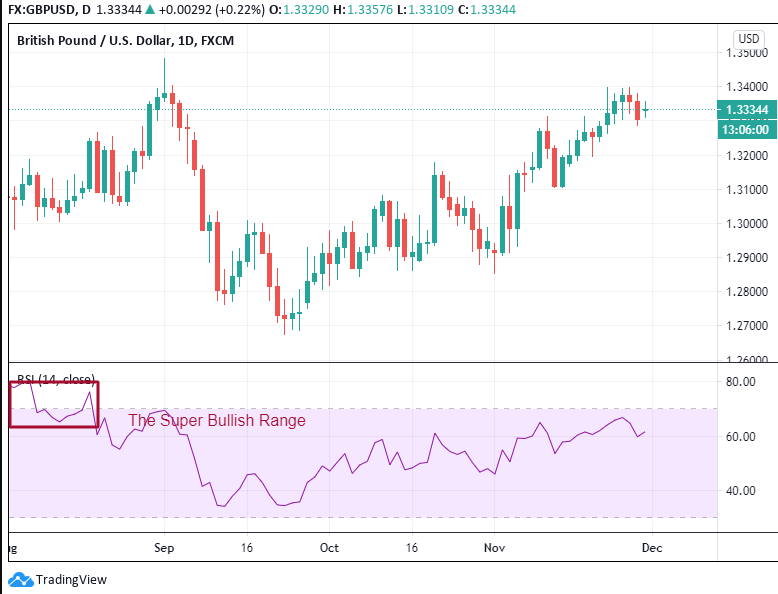Traders assess market trends and fluctuations in price via technical analysis. There are tools called momentum oscillators that allow you to figure out the alterations in price. One such tool is the Relative Strength Index (RSI), using which traders can know when the direction of a financial instrument is going to change.
What is the Relative Strength Index?
The RSI is a tool that merchants can use to decide whether a trade is strong or weak. It is depicted as a line graph flanked by two ultimates.
After normalization, the RSI is represented in a 0-100 range. When it has a value that’s greater than 70, the RSI is said to be overbought. In contrast, it is said to be overvalued/oversold when it is less than 30.
We can use the below formula to compute the RSI value:

Example of Relative Strength Index
In order to better understand the RSI, let us analyze the graph below:

Here, the blue line depicts the stock’s Relative Strength Index oscillating between 30 and 70. When it exceeds the 30-mark, it suggests that the region is oversold, in which event the stock goes back up. When it crosses the 70-mark, it depicts an overbought region, following which a dip in the rate of the stock occurs.
Based on excessive selling or purchasing, the RSI can be applied to select potential tops and bottoms. Note the following EUR/USD chart, which is calculated for 4 hours.

It is clear that there has been a drop in EUR/USD, with the value decreasing by 400 pips for 14 days. If you look at the reading for June 7, you will see that it is below 1.2000. But, due to the dip in the RSI below 30, it denotes that the current market has no sellers at all, thus signaling the end of the move.
In the subsequent two weeks, a price reversal occurs, as EUR/USD went back up.
How to trade using RSI
Now, let us look at how to trade using the RSI for the two signals.
Overbought Signal
While trading an overbought signal, one of the following two strategies might be employed by the trader:
- A trader going long might use the overbought signal as a sign to secure their gain from the trade they may be engaged in. They can initiate a long trade by buying with the hope of selling in the future for a higher price in order to make a profit. The rise of a market presents the perfect circumstance for a trader to sell and get out of the position.
- If the number of open positions for a trader is null, the signal being overbought might cause them to initiate a short trade. When the trader predicts the market to fall, they often initiate a short trade by selling the stock, intending to repurchase it in the future for a much lower price. This allows them to make substantial profits.
Oversold Signal
In the case of an oversold signal, a trader might employ one of these two strategies:
- In the event of any open positions not being available, a trader might initiate a long trade, taking the oversold signal as a sign. Thus, they enter the market with purchase with the hopes of selling in the future for a higher price. This is a reasonable assumption as an oversold signal generally signifies a price rise in the future.
- If a trader has already performed short selling, the oversold signal might lead them to lock in their profit, provided a fall in the price has taken place, after which they can buy and end the trade.
Determining the trend with RSI
An asset’s trend can be computed with the aid of the Relative Strength Index. Five different types of range shifts are present that can help a trader in this endeavor. These are as follows:
- Bullish Range. As per observations made by traders, the RSI oscillates between 40 and 80 in the Bullish Range. When the value reaches 40, it indicates an oversold zone, and when it reaches 80, the zone is said to be overbought.
- Super Bullish Range. It is a common occurrence for the RSI to swing in the 60-80 range in the Super Bullish range. When the RSI lies between 60 and 65, traders have a great chance to make a purchase as the market is extremely likely to rise from this position.

- Bearish Range. The RSI in the Bearish Range has the tendency to oscillate in the zone between 20 and 65. When the RSI reaches the zone lying between 60 and 65, the area is said to be overbought. This is a decent selling point for the RSI targets of 20 and 40, and as the value reaches 20, the zone is oversold. A trader utilizes this chance to enter a long trade.

- Super Bearish Range. In this range, the RSI oscillates between 20 and 40 zones. Because the oscillator cannot move beyond 40, the stick exhibits a firm resilience to greater prices. Hence, traders can sell whenever the RSI reaches the level of 40.
- Sideways Range. In this range, the RSI oscillates between 40 and 60. Thus, traders can make a long trade at 40 with 60 RSI as a target. On the other hand, they can short trade at 60 with 40 RSI as a target. But, as a general rule, a sideways range causes traders to avoid trading.
Key takeaways
So, we have explained the Relative Strength Index to you in detail, along with instances and how to conduct dealings using the same. Furthermore, we saw how a trader could use range shifts to conduct better trades keeping in line with the changing markets. If you are a novice trader, you should learn how to interpret an indicator exactly and check all the various parameters before beginning.




